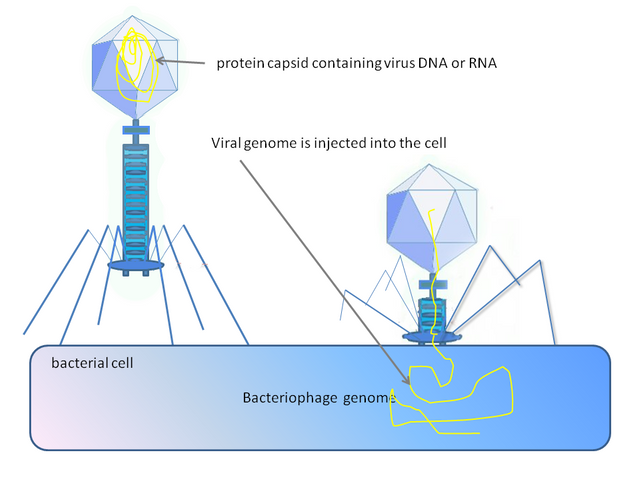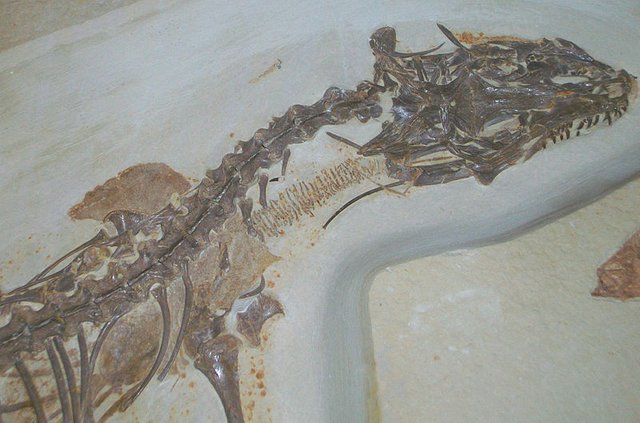Da Vinci Times #3.0
Adapt without muting DNA
Some viruses are able to produce an "unstable" protein, which allows them to easily infect various organisms.
 Imagine CC0 Creative Commons - Source
Imagine CC0 Creative Commons - SourceTo infect a cell, a virus must recognize the molecular receptors on the cell surface. The recognition occurs when two specific proteins (of the cell and one of the virus) interact with each other. A fundamental problem is to understand how viruses change, how they adapt to face the immune responses of various organisms. If adaptation were dictated only by random mutations, it would be much slower than observed.
The researchers found that "lambda" phages are able to synthesize, starting from the same sequence of DNA, an "unstable" protein, which adapts to the different types of receptors present on different bacteria. This could explain the great plasticity of phages in infecting new organisms. It is important to emphasize that this adaptation is not due to a genetic mutation. Now scientists are trying to understand how this mechanism is widespread in the world of viruses.
Another pair of eyes
According to a new study, the Seniwa ensidens, a lizard endemic in Wyoming in the Eocene, could have had four eyes, and it would be the first and only known example among vertebrates.

Imagine CC0 Creative Commons - Source
This research represents an important achievement, because for a long time scientists have been trying to elucidate the embryogenesis of the third eye present in some modern lizards, which can be linked to the pineal organ or the parapineal one.
Now we are facing a third possibility, which foresees the presence in ancestral vertebrates of four eyes: the normal two and the two originated by the current pineal and parapineable glands. Over time, due to the loss of function of the second pair of eyes, the glands have specialized in different functions, maintaining in some species a receptor-like role.
Article source
The hospitable Venus’ atmosphere
Recent research shows that resistant bacteria in acidic environments can survive in the high atmosphere of Venus

Imagine CC0 Creative Commons - Source
Venus is the most similar planet to the Earth, by mass and size, but not for the climate conditions. In fact, the temperature of its surface is about 400 degrees Celsius. But, at height of about 50 km, the climatic conditions could be much more favorable to microbial life. The pressure is like at sea level, the temperatures of the order of 60 ° C. Nutrients like sulfur and carbon dioxide are also present. Analyzing the Venusian clouds, scientists hypothesized that some bacteria could actually be present in the clouds.
Post of the day

Imagine CC0 Creative Commons - Source
@alexdory discusses again about the colonization of Mars: what will be problems that we will face in order to survive where it seems impossible? And how could we exploit elements of the Red Planet to our advantage?

Immagine CC0 Creative Commons, si ringrazia @mrazura per il logo ITASTEM.
CLICK HERE AND VOTE FOR DAVINCI.WITNESS
Keep in mind that for organizational reasons it’s necessary to use “steemstem” and “davinci-times” tags to be voted.
@aboutcoolscience - @spaghettiscience - @rscalabrini
Adattarsi senza mutare il DNA
Alcuni virus sono in grado di produrre una proteina “instabile”, che permette loro di infettare diversi organismi con notevole facilità.
 Imagine CC0 Creative Commons - Source
Imagine CC0 Creative Commons - SourcePer attaccare una cellula, un virus deve riconoscere i recettori molecolari presenti sulla superficie della cellula stessa. Il riconoscimento avviene quando due proteine specifiche (dell’ospite e dell’invasore) entrano in contatto tra di loro. Un problema fondamentale è capire come i virus mutano, cioè come si adattano per contrastare le risposte immunitarie dei vari organismi. Se l’adattamento fosse dettato solamente da mutazioni casuali, sarebbe molto più lento di quanto osservato.
I ricercatori hanno scoperto che i fagi “lambda” sono in grado di sintetizzare, a partire dalla stessa sequenza di DNA, una proteina “instabile”, che si adatta ai diversi tipi di recettori presenti su batteri differenti. Questo potrebbe spiegare la grande plasticità dei fagi nell’infettare nuovi organismi. È importante sottolineare che questo adattamento non è dovuto a una mutazione genetica. Ora gli scienziati stanno cercando di capire quanto questo meccanismo è diffuso nel mondo dei virus.
Un’altra coppia di occhi
Secondo un nuovo studio, la lucertola Seniwa ensidens, endemica del Wyoming nel periodo dell'Eocene, avrebbe avuto quattro occhi, e sarebbe il primo e unico casa documentate tra i vertebrati.

Imagine CC0 Creative Commons - Source
Questa scoperta rappresenta un'importante conquista in quanto da tempo gli scienziati cercavano di collocare, dal punto di vista embriologico, un abbozzo di terzo occhio presente in alcune lucertole moderne, ricollegabile all'organo pineale o a quello parapineale.
Ora si aprono le porte per un terza possibilità, che prevede la presenza in vertebrati ancestrali di quattro occhi: i due classici e i due originati dalle attuali ghiandole pineali e parapineali. Col tempo e con la perdita di funzione della seconda coppia di occhi, le ghiandole si sono specializzate nell'assolvere funzioni differenti, mantenendo in alcune specie un ruolo simil-recettore.
Article source
L’atmosfera ospitale di Venere
Una ricerca recente mostra come alcuni batteri resistenti in ambienti acidi potrebbero sopravvivere nell’alta atmosfera di Venere.

Imagine CC0 Creative Commons - Source
Venere è il pianeta più simile alla Terra, per massa e dimensioni, ma non per il clima. Il suolo è a temperature dell’ordine dei 400 gradi Celsius. Tuttavia a un altezza di circa 50 Km le condizioni climatiche potrebbero essere molto più favorevoli alla vita microbica. La pressione è come quella a livello del mare, le temperature dell’ordine dei 60 °C. Sono inoltre presenti dei nutrienti come zolfo e biossido di carbonio. Analizzando le nubi venusiane gli scienziati hanno ipotizzato che alcuni batteri potrebbero essere effettivamente presenti tra le nubi.
Post del giorno

Imagine CC0 Creative Commons - Source
@alexdory torna a parlarci della colonizzazione di Marte, di quali saranno i problemi da affrontare per sopravvivere là dove sembra impossibile, e di come potremmo sfruttare a nostro vantaggio gli elementi del Pianeta Rosso.

Immagine CC0 Creative Commons, si ringrazia @mrazura per il logo ITASTEM.
CLICK HERE AND VOTE FOR DAVINCI.WITNESS
Si ricorda che per motivi organizzativi è necessario utilizzare le tag “steemstem” e “davinci-times” per essere votati.
@aboutcoolscience - @spaghettiscience - @rscalabrini
Sempre alla ricerca di articoli importanti e di spessore! Ogni giorno imparo qualcosa d’inteessante! Grazie ragazzi per lo splendido lavoro. Un saluto @giornalista
Ottimo lavoro come sempre! Amo particolarmente l'articolo su Marte, contiene molti spunti interessanti ed un approccio divulgativo che lo rende masticabile anche ai profani! Ben fatto, ottimo assortimento di articoli! keep it up!
Bravi, bei articoli
Being A SteemStem Member